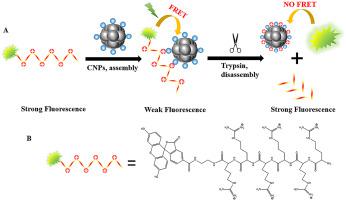Journal of Pharmaceutical Analysis ( IF 8.8 ) Pub Date : 2020-08-27 , DOI: 10.1016/j.jpha.2020.08.009 Shanshan Hou , Tingting Feng , Na Zhao , Jiaxin Zhang , Huibin Wang , Ning Liang , Longshan Zhao

|
Herein, we report a novel sensor to detect trypsin using a purpose-designed fluorescein-labelled peptide with negatively charged carbon nanoparticles (CNPs) modified by acid oxidation. The fluorescence of the fluorescein-labelled peptide was quenched by CNPs. The sensor reacted with trypsin to cleave the peptide, resulting in the release of the dye moiety and a substantial increase in fluorescence intensity, which was dose- and time-dependent, and trypsin could be quantified accordingly. Correspondingly, the biosensor has led to the development of a convenient and efficient fluorescent method to measure trypsin activity, with a detection limit of 0.7 μg/mL. The method allows rapid determination of trypsin activity in the normal and acute pancreatitis range, suitable for point-of-care testing. Furthermore, the applicability of the method has been demonstrated by detecting trypsin in spiked urine samples.
中文翻译:

定制的碳纳米颗粒-肽荧光传感器,用于简单,灵敏地检测胰蛋白酶
在本文中,我们报告了一种新型传感器,可使用目的设计的荧光素标记肽和经酸氧化修饰的带负电的碳纳米颗粒(CNP)检测胰蛋白酶。荧光素标记的肽的荧光被CNP淬灭。传感器与胰蛋白酶反应以切割肽,导致染料部分的释放和荧光强度的显着增加,这是剂量和时间依赖性的,因此可以对胰蛋白酶进行定量。相应地,生物传感器导致了一种方便有效的荧光方法来测量胰蛋白酶活性,其检测极限为0.7μg/ mL。该方法可快速测定正常和急性胰腺炎范围内的胰蛋白酶活性,适用于即时检验。此外,


























 京公网安备 11010802027423号
京公网安备 11010802027423号